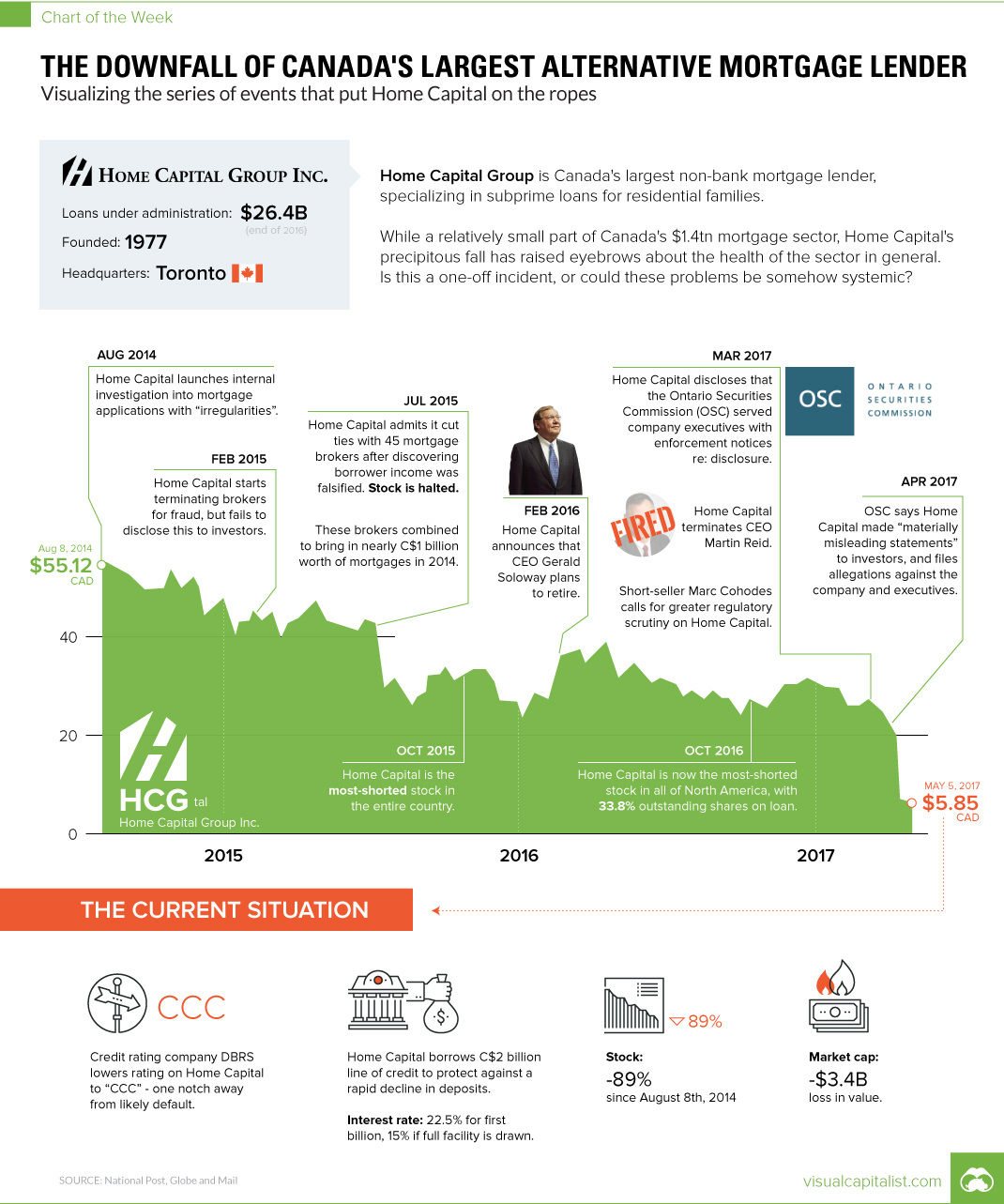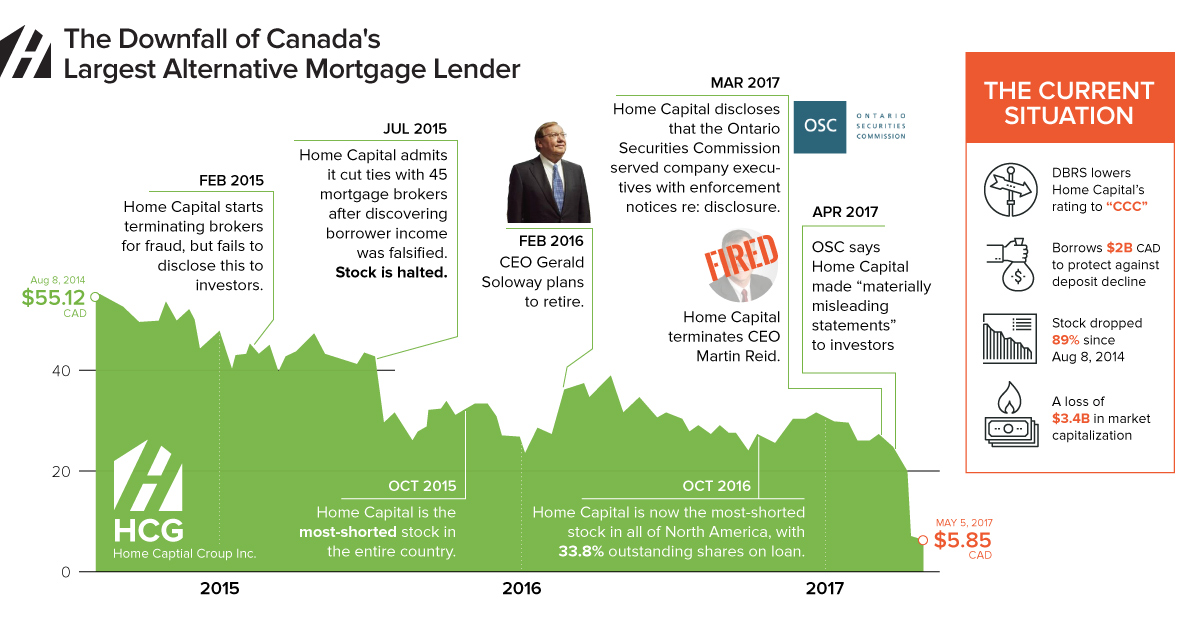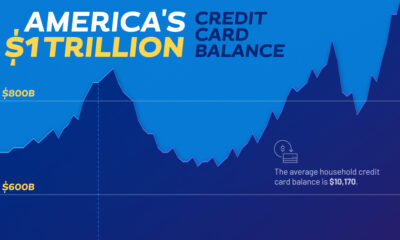Markets
Chart: The Downfall of Canada’s Largest Alternative Mortgage Lender

The Downfall of Home Capital
And what it could mean to global investors
The Chart of the Week is a weekly Visual Capitalist feature on Fridays.
If history does indeed rhyme, then the saga of Canada’s largest alternative mortgage lender could be the opening act in a Shakespearean financial tragedy.
Home Capital Group, the country’s leader in subprime residential loans, is finally on the ropes after years of speculation. The company was the most-shorted stock in Canada at various points in 2015, and it also took the crown as the most-shorted stock in North America for durations of 2016.
Those bears are likely buying the drinks this weekend. Home Capital’s stock has fallen 89% from its peak in August 2014, and over that time the company has shed over $3.4 billion of market capitalization. The biggest portion of the fall came just weeks ago, when depositors withdrew nearly $600 million in cash from Home Capital Group’s balance sheet.
In more recent news: the company has also had its credit rating downgraded, opened an emergency credit facility of $2 billion with sky-high interest rates, and shook up its board as part of a “governance renewal”. Oh, and all of this is happening while regulators pursue allegations that the company intentionally misled investors.
Part of a Bigger Narrative
It’s no secret that Canada’s housing and mortgage sector has been precarious for some time.
While the country’s banks and real estate sector largely shook off the effects of the Financial Crisis, the market has been bubbly and speculative since then. We previously noted the insanity of Vancouver’s real estate market, and even The Economist was calling Canada the most overvalued housing market in the world years ago.
Not much has changed. Governments have tried to step in with foreign buyer taxes, but it’s not enough to stop skyrocketing prices in Toronto. At the same time, Vancouver is also rebounding from recent government interventions to try and cool off the local market. In fact, prices there are up 5% in just three months.
While Home Capital Group is a relatively small fish in the Canadian mortgage pond, the saga has also prompted global investors to think deeper about Canadian housing. Are the issues with Home Capital a one-off, or are they systemic to the market as a whole? Is there a possibility of widespread contagion?
Gut Check Time
Markets are divided on the above issues for now. Some analysts are calling Home Capital a speculative buying opportunity, while others see it as a potential trigger for the puncture of the Canadian housing bubble.
Contagion has already been spreading, especially to other lenders such as Equitable Group – a company with a similar business model, that has seen shares fall 34% over the last month.
Home Capital contagion has spread to the entire mortgage market, in particular alternative mortgage lenders. Our channel checks suggest [Equitable Group’s] deposit-gathering capabilities will be impaired.
Jaeme Gloyn, National Bank (April 27th, 2017)
At the same time, house prices continue to increase – and governments are doing everything in their power to cool them off without triggering a recession. It’s a financial tightrope act that will be watched closely by investors around the world.
If the Home Capital saga is indeed just the opening act of a Shakespearean financial tragedy, then the following act will also be one to watch.
Markets
The European Stock Market: Attractive Valuations Offer Opportunities
On average, the European stock market has valuations that are nearly 50% lower than U.S. valuations. But how can you access the market?

European Stock Market: Attractive Valuations Offer Opportunities
Europe is known for some established brands, from L’Oréal to Louis Vuitton. However, the European stock market offers additional opportunities that may be lesser known.
The above infographic, sponsored by STOXX, outlines why investors may want to consider European stocks.
Attractive Valuations
Compared to most North American and Asian markets, European stocks offer lower or comparable valuations.
| Index | Price-to-Earnings Ratio | Price-to-Book Ratio |
|---|---|---|
| EURO STOXX 50 | 14.9 | 2.2 |
| STOXX Europe 600 | 14.4 | 2 |
| U.S. | 25.9 | 4.7 |
| Canada | 16.1 | 1.8 |
| Japan | 15.4 | 1.6 |
| Asia Pacific ex. China | 17.1 | 1.8 |
Data as of February 29, 2024. See graphic for full index names. Ratios based on trailing 12 month financials. The price to earnings ratio excludes companies with negative earnings.
On average, European valuations are nearly 50% lower than U.S. valuations, potentially offering an affordable entry point for investors.
Research also shows that lower price ratios have historically led to higher long-term returns.
Market Movements Not Closely Connected
Over the last decade, the European stock market had low-to-moderate correlation with North American and Asian equities.
The below chart shows correlations from February 2014 to February 2024. A value closer to zero indicates low correlation, while a value of one would indicate that two regions are moving in perfect unison.
| EURO STOXX 50 | STOXX EUROPE 600 | U.S. | Canada | Japan | Asia Pacific ex. China |
|
|---|---|---|---|---|---|---|
| EURO STOXX 50 | 1.00 | 0.97 | 0.55 | 0.67 | 0.24 | 0.43 |
| STOXX EUROPE 600 | 1.00 | 0.56 | 0.71 | 0.28 | 0.48 | |
| U.S. | 1.00 | 0.73 | 0.12 | 0.25 | ||
| Canada | 1.00 | 0.22 | 0.40 | |||
| Japan | 1.00 | 0.88 | ||||
| Asia Pacific ex. China | 1.00 |
Data is based on daily USD returns.
European equities had relatively independent market movements from North American and Asian markets. One contributing factor could be the differing sector weights in each market. For instance, technology makes up a quarter of the U.S. market, but health care and industrials dominate the broader European market.
Ultimately, European equities can enhance portfolio diversification and have the potential to mitigate risk for investors.
Tracking the Market
For investors interested in European equities, STOXX offers a variety of flagship indices:
| Index | Description | Market Cap |
|---|---|---|
| STOXX Europe 600 | Pan-regional, broad market | €10.5T |
| STOXX Developed Europe | Pan-regional, broad-market | €9.9T |
| STOXX Europe 600 ESG-X | Pan-regional, broad market, sustainability focus | €9.7T |
| STOXX Europe 50 | Pan-regional, blue-chip | €5.1T |
| EURO STOXX 50 | Eurozone, blue-chip | €3.5T |
Data is as of February 29, 2024. Market cap is free float, which represents the shares that are readily available for public trading on stock exchanges.
The EURO STOXX 50 tracks the Eurozone’s biggest and most traded companies. It also underlies one of the world’s largest ranges of ETFs and mutual funds. As of November 2023, there were €27.3 billion in ETFs and €23.5B in mutual fund assets under management tracking the index.
“For the past 25 years, the EURO STOXX 50 has served as an accurate, reliable and tradable representation of the Eurozone equity market.”
— Axel Lomholt, General Manager at STOXX
Partnering with STOXX to Track the European Stock Market
Are you interested in European equities? STOXX can be a valuable partner:
- Comprehensive, liquid and investable ecosystem
- European heritage, global reach
- Highly sophisticated customization capabilities
- Open architecture approach to using data
- Close partnerships with clients
- Part of ISS STOXX and Deutsche Börse Group
With a full suite of indices, STOXX can help you benchmark against the European stock market.

Learn how STOXX’s European indices offer liquid and effective market access.

-

 Economy2 days ago
Economy2 days agoEconomic Growth Forecasts for G7 and BRICS Countries in 2024
The IMF has released its economic growth forecasts for 2024. How do the G7 and BRICS countries compare?
-

 Markets1 week ago
Markets1 week agoU.S. Debt Interest Payments Reach $1 Trillion
U.S. debt interest payments have surged past the $1 trillion dollar mark, amid high interest rates and an ever-expanding debt burden.
-

 United States2 weeks ago
United States2 weeks agoRanked: The Largest U.S. Corporations by Number of Employees
We visualized the top U.S. companies by employees, revealing the massive scale of retailers like Walmart, Target, and Home Depot.
-

 Markets2 weeks ago
Markets2 weeks agoThe Top 10 States by Real GDP Growth in 2023
This graphic shows the states with the highest real GDP growth rate in 2023, largely propelled by the oil and gas boom.
-

 Markets2 weeks ago
Markets2 weeks agoRanked: The World’s Top Flight Routes, by Revenue
In this graphic, we show the highest earning flight routes globally as air travel continued to rebound in 2023.
-

 Markets2 weeks ago
Markets2 weeks agoRanked: The Most Valuable Housing Markets in America
The U.S. residential real estate market is worth a staggering $47.5 trillion. Here are the most valuable housing markets in the country.
-

 Energy1 week ago
Energy1 week agoThe World’s Biggest Nuclear Energy Producers
-

 Money2 weeks ago
Money2 weeks agoWhich States Have the Highest Minimum Wage in America?
-

 Technology2 weeks ago
Technology2 weeks agoRanked: Semiconductor Companies by Industry Revenue Share
-

 Markets2 weeks ago
Markets2 weeks agoRanked: The World’s Top Flight Routes, by Revenue
-

 Countries2 weeks ago
Countries2 weeks agoPopulation Projections: The World’s 6 Largest Countries in 2075
-

 Markets2 weeks ago
Markets2 weeks agoThe Top 10 States by Real GDP Growth in 2023
-

 Demographics2 weeks ago
Demographics2 weeks agoThe Smallest Gender Wage Gaps in OECD Countries
-

 United States2 weeks ago
United States2 weeks agoWhere U.S. Inflation Hit the Hardest in March 2024















